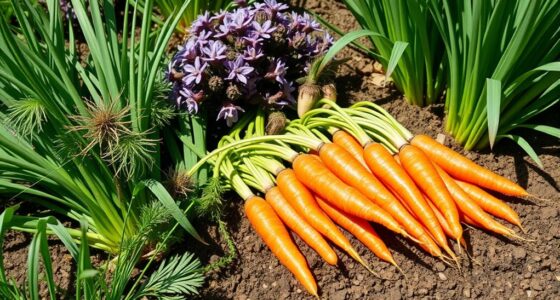To create effective raised bed companion planting layouts, position tall plants like corn or sunflowers at the back to avoid shading shorter crops. Use strategic placements such as herbs like basil near peppers to repel pests, and plant nitrogen-fixers like beans to enrich the soil naturally. Incorporate pest-repellent plants like marigolds and rotate crops seasonally for healthy soil. Exploring these strategies helps you maximize space and naturally manage pests—discover how these ideas work together for a thriving garden.
Key Takeaways
- Arrange tall crops to shield shorter plants from excessive shading, optimizing sunlight exposure for all species.
- Position aromatic herbs near susceptible vegetables to naturally repel pests and promote plant health.
- Use raised beds for crop rotation, alternating plant families to maintain soil fertility and reduce pests.
- Incorporate beneficial companion plants like marigolds and basil to deter pests and enhance growth.
- Plan dynamic layouts that allow seasonal adjustments, improving pest management and soil conditions over time.

Raised beds offer an efficient way to improve your garden’s productivity and manage challenging soil conditions. When planning your layout for companion planting, you’re setting the stage for healthier plants and better yields. By carefully arranging different crops, you can naturally boost soil fertility, reduce pest problems, and maximize space. Think of companion planting as a strategic dance where each plant plays a role in supporting others. For example, placing nitrogen-fixing plants like beans near heavy feeders such as tomatoes can enhance soil nutrients, reducing the need for synthetic fertilizers. This approach keeps your soil healthy and productive over time, making your raised beds more sustainable.
Pest management is another essential factor when designing your companion planting layout. Certain plants can act as natural repellents or trap crops, drawing pests away from your main vegetables. For instance, marigolds are known to deter nematodes and aphids, so placing them around your bed’s perimeter can serve as a protective barrier. Similarly, basil planted near peppers can help repel thrips and mosquitoes, creating a more pest-resistant environment. The key is to understand which plants complement each other and which ones can fight off common pests. This not only reduces your reliance on chemical pesticides but also promotes a healthier, more balanced ecosystem within your garden.
When designing your layout, consider how plants grow and interact over the season. Tall plants like corn or sunflowers should be positioned to avoid shading shorter crops, while root crops like carrots and beets can fill in gaps between taller plants. Companion planting isn’t just about placement; it’s about understanding plant behaviors and their effects on each other. For example, planting aromatic herbs such as thyme or mint near cabbage can help ward off cabbage worms and aphids. By mixing these plants thoughtfully, you create a natural pest management system that keeps your garden thriving without chemical intervention. Plus, these combinations often improve the flavor and health of your vegetables.
Finally, remember that companion planting isn’t a static plan. It requires observation and adjustment as your garden grows. Keep track of what works and what doesn’t, and don’t be afraid to experiment with different configurations. Over time, you’ll develop a keen sense of how to optimize space, enhance soil fertility, and manage pests naturally. Raised beds give you the flexibility to rotate and rearrange crops easily, so you can refine your layout season after season. By integrating these strategies, you’ll cultivate a resilient, productive garden that benefits from natural relationships between plants and smarter pest management techniques.
Frequently Asked Questions
How Do I Choose the Best Companion Plants for My Climate?
When choosing the best companion plants for your climate, consider soil compatibility and plant diversity. You want plants that thrive in your local conditions and enhance each other’s growth. Research which plants naturally grow well together and suit your soil type. By mixing diverse plants, you improve soil health and pest resistance. Adjust your choices based on your specific climate to create a thriving, balanced garden.
Can I Rotate Plants Within the Same Bed Annually?
Did you know that rotating crops can increase soil fertility by up to 20%? Yes, you can rotate plants within the same bed annually, but it’s essential to contemplate seasonal crop rotation and companion planting timing. This helps prevent pests, reduce disease, and maintain soil health. Plan your planting schedule carefully each year, ensuring different plant families follow one another, maximizing your garden’s productivity and sustainability.
What Are Common Mistakes in Companion Planting Layouts?
You should avoid common mistakes in companion planting layouts, like falling for companion plant myths that can lead to ineffective pairings. Don’t rely on monoculture pitfalls, such as planting too many of the same crops together, which can attract pests and deplete soil nutrients. Instead, diversify your layout thoughtfully, rotate plant types, and use well-researched companion pairs to promote healthy growth and pest control.
How Do I Prevent Pests Using Companion Planting?
Imagine your garden thriving without pests—companion planting can make that happen. You attract beneficial insects by planting flowers like marigolds near your vegetables, which helps control pests naturally. Use pest-resistant varieties to reduce vulnerability, and space plants strategically to encourage beneficial insect activity. By combining pest-resistant plants with beneficial insect attraction, you create a natural pest barrier, reducing the need for chemical interventions and promoting a healthy, balanced garden.
Are There Specific Soil Requirements for Different Plant Combinations?
You wonder if specific soil requirements matter for plant combinations. Yes, soil compatibility and nutrient requirements vary among plants; some need more nitrogen, others thrive in well-drained soil. When planning your planting layout, match plants with similar needs to guarantee healthy growth. Adjust soil conditions accordingly by adding organic matter or fertilizers to meet their nutrient demands. This approach helps your garden flourish and reduces competition for resources.
Conclusion
By using these companion planting layouts, you’ll transform your raised bed into a thriving, harmonious garden. Think of it like a well-orchestrated symphony, where each plant plays its perfect part. With thoughtful placement and strategic planning, you’ll boost your yields, repel pests, and enjoy a more bountiful harvest. So get started today—your garden will thank you as much as a lush, vibrant oasis after a long drought. Happy planting!









